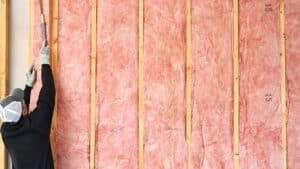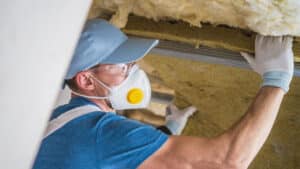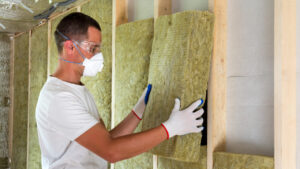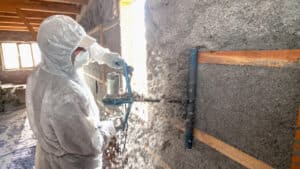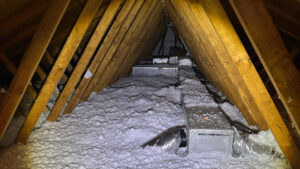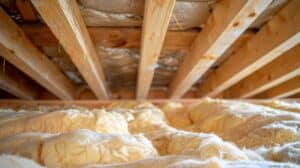Is your home truly safe from fire hazards? Fire-resistant cellulose insulation offers a solution that can protect your home while providing excellent thermal performance. This article explores how cellulose insulation resists fire, its performance in tests, and its additional benefits.
We’ll also cover important considerations before installation. By understanding fire retardant treatments and building insulation properties, you’ll learn how this material can enhance your home’s safety and energy efficiency.
What is Fire-Retardant Treatment for Cellulose Insulation?

Fire-retardant treatment for cellulose insulation is a crucial process that enhances the safety of thermal insulation in buildings. This treatment involves applying special chemicals to the cellulose fibers, making them resistant to fire and slowing down flame spread.
The treatment process typically occurs during manufacturing, where borate compounds are added to the cellulose material. These compounds not only provide fire resistance but also offer protection against mold and pests, making them an excellent choice for insulating crawl spaces and attics in Portsmouth homes.
While cellulose insulation is not entirely fireproof, the fire-retardant treatment significantly improves its performance compared to untreated materials. In the event of a fire, treated cellulose insulation chars rather than ignites, helping to contain the spread of flames and potentially saving lives and property.
It’s important to note that while fire-retardant cellulose insulation offers excellent protection, it’s just one part of a comprehensive fire safety strategy for buildings. Proper installation by professionals and regular maintenance are essential for maximizing its effectiveness:
- Treat cellulose fibers with fire-retardant chemicals
- Apply during the manufacturing process
- Improve fire resistance and safety in buildings
- Combine with proper installation and maintenance
How Does Cellulose Insulation Resist Fire?

Cellulose insulation’s fire resistance stems from three key mechanisms: the charring effect, high-temperature resistance, and oxygen restriction. These properties not only protect walls from fire but also provide excellent soundproofing. Unlike mineral wool, cellulose insulation offers additional benefits such as pest deterrence, making it a versatile choice for home insulation.
Charring Effect
The charring effect is a crucial aspect of cellulose insulation’s fire resistance. When exposed to high temperatures, the fire retardant-treated cellulose fibers form a protective char layer, slowing the spread of flames and heat transfer. This process helps safeguard the structural integrity of walls and ducts in homes, providing valuable time for evacuation and firefighting efforts.
In addition to fireproofing, the charring effect of cellulose insulation offers an extra layer of protection for homes. As the outer layer of insulation chars, it creates a barrier that limits the oxygen supply to the fire, effectively smothering it. This unique property of treated paper-based cellulose insulation sets it apart from other insulation materials:
| Property | Benefit |
|---|---|
| Charring Effect | Slows fire spread |
| Oxygen Restriction | Smothers flames |
| Heat Transfer Reduction | Protects structure |
High-Temperature Resistance
Cellulose insulation’s high-temperature resistance stems from its fire-retardant treatment, allowing it to withstand extreme heat without igniting. This property makes cellulose an environmentally friendly and budget-conscious choice for homeowners seeking effective fire protection. The treated fibers can endure temperatures far beyond what typical household fires produce, providing crucial time for occupants to evacuate safely.
In addition to its fire-resistant qualities, cellulose insulation offers excellent waterproofing and mold prevention capabilities. The borate compounds used in the treatment process not only enhance fire resistance but also create an inhospitable environment for mold growth. This multi-functional approach to home protection makes cellulose insulation a cost-effective solution for homeowners concerned about fire safety, moisture control, and indoor air quality.
Oxygen Restriction
The dense structure of cellulose fibers limits air circulation within walls and attics, effectively starving potential fires of oxygen. This feature complements other energy conservation measures, such as properly sealed windows, to create a more fire-resistant and energy-efficient home.
The oxygen-restricting nature of cellulose insulation also contributes to its effectiveness in pest control. By limiting air pockets where insects might grow, cellulose creates an inhospitable environment for pests. Unlike some types of wool insulation, cellulose maintains its structure even when exposed to water which ensures consistent performance in various conditions. Cellulose is also budget-friendly
Does Cellulose Insulation Perform Well in Fire Tests?

Cellulose insulation has demonstrated impressive fire safety performance in various tests, showcasing its effectiveness in protecting homes. It has achieved a Class 1 Fire Rating, which is the highest rating possible, with a flame spread index of less than 25 and smoke development of less than 50.
This rating indicates that cellulose insulation significantly slows the spread of flames and produces minimal smoke during a fire. Furthermore, when compared to untreated materials, cellulose insulation has shown an increase in fire resistance performance ranging from 22% to 55%. This substantial improvement in fire resistance can be crucial in preventing the rapid spread of fire within a structure.
Additionally, when used in wall assemblies, cellulose insulation has demonstrated the ability to create firewalls with a one-hour or greater fire resistance rating. This means that walls insulated with cellulose can potentially withstand fire exposure for an hour or more, providing valuable time for occupants to evacuate and for firefighters to respond.
What Other Benefits Does Cellulose Insulation Offer?

Cellulose insulation offers excellent thermal performance, reducing heat transfer and improving energy efficiency in homes. Its dense fiber structure effectively traps air, creating a barrier against temperature fluctuations and lowering heating and cooling costs. Mineral wool is an environmentally friendly option.
As a sustainable building material, cellulose insulation helps reduce air pollution by using recycled paper products. This eco-friendly option minimizes landfill waste and requires less energy to manufacture compared to other insulation types.
Homeowners benefit from cellulose insulation’s moisture management properties. The borate compounds used in its treatment help prevent mold growth and resist water absorption, making it ideal for the region’s climate.
Cellulose insulation provides superior sound-dampening qualities, creating a quieter living environment. Its density and composition effectively absorb sound waves, reducing noise transmission between rooms and from external sources. Key benefits of cellulose insulation include:
- Enhanced thermal performance
- Eco-friendly composition
- Moisture resistance
- Improved sound insulation
- Cost-effective installation
What Should You Know Before Installing Cellulose Insulation?

Before installing cellulose insulation, homeowners should consult with a professional insulation contractor to assess their home’s specific needs. An energy audit can help identify areas of heat loss and determine the appropriate thermal insulation levels for optimal energy efficiency.
Proper preparation of the construction site is crucial for effective cellulose insulation installation. Sealing air leaks and addressing any moisture issues in the attic to be insulated are essential steps that should be completed before the insulation process begins.
Homeowners should be aware that cellulose insulation installation requires specialized equipment and expertise. Professional insulation services ensure that the material is applied at the correct density and depth, maximizing its fire-resistant and energy-saving properties.
After installation, it’s important to schedule regular inspections with an insulation contractor to maintain the effectiveness of cellulose insulation. These check-ups can identify any settling or compression issues that may affect the insulation’s performance over time.
Contact Universal Insulation Doctor today for expert cellulose insulation installation!
Ready to enhance your home’s fire safety and energy efficiency? Don’t compromise on your home’s safety and comfort. Universal Insulation Doctor specializes in fire-resistant cellulose insulation that not only protects your property but also saves you money on energy bills. Our team of certified professionals will assess your home’s needs, provide a customized insulation plan, and ensure flawless installation.
With our top-quality cellulose insulation, you’ll enjoy peace of mind knowing your home is better protected against fire hazards while staying cozy year-round. Call us now at 757-962-0340 or visit our website to schedule your free consultation and take the first step towards a safer, more efficient home.
Frequently Asked Questions
How is cellulose insulation treated to make it fire-resistant?
Cellulose insulation is treated with fire-retardant chemicals, typically borates, during the manufacturing process. These chemicals are mixed with recycled paper fibers, making the insulation resistant to flames and slowing the spread of fire in residential and commercial buildings.
What makes cellulose insulation effective at resisting fire?
Cellulose insulation's fire resistance stems from its treatment with borate compounds. These chemicals create a protective barrier when exposed to heat, slowing flame spread and reducing oxygen availability. This fire-retardant property makes cellulose insulation an effective choice for improving home safety and energy efficiency.
How does cellulose insulation perform in standardized fire tests?
Cellulose insulation performs exceptionally well in standardized fire tests. Its treated fibers resist flame spread and smoke development, meeting or exceeding building code requirements. Cellulose's dense structure also helps slow fire progression, providing valuable time for evacuation and firefighting efforts in residential settings.
What additional advantages does cellulose insulation provide besides fire resistance?
Cellulose insulation offers several advantages beyond fire resistance. It provides excellent sound dampening, reducing noise transmission between rooms. Additionally, cellulose is an eco-friendly option, made from recycled materials and requiring less energy to produce than other insulation types. It also effectively fills small gaps and crevices, improving overall insulation performance.
What important factors should homeowners consider before installing cellulose insulation?
Homeowners should consider several factors before installing cellulose insulation, including the building's moisture levels, air sealing needs, local climate, and existing insulation. They should also evaluate the insulation's R-value, fire resistance, and potential for settling over time. Professional installation is crucial for optimal performance and safety.

